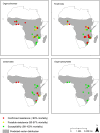An online tool for mapping insecticide resistance in major Anopheles vectors of human malaria parasites and review of resistance status for the Afrotropical region
- PMID: 24559061
- PMCID: PMC3942210
- DOI: 10.1186/1756-3305-7-76
An online tool for mapping insecticide resistance in major Anopheles vectors of human malaria parasites and review of resistance status for the Afrotropical region
Abstract
Background: Malaria control programmes across Africa and beyond are facing increasing insecticide resistance in the major anopheline vectors. In order to preserve or prolong the effectiveness of the main malaria vector interventions, up-to-date and easily accessible insecticide resistance data that are interpretable at operationally-relevant scales are critical. Herein we introduce and demonstrate the usefulness of an online mapping tool, IR Mapper.
Methods: A systematic search of published, peer-reviewed literature was performed and Anopheles insecticide susceptibility and resistance mechanisms data were extracted and added to a database after a two-level verification process. IR Mapper ( http://www.irmapper.com) was developed using the ArcGIS for JavaScript Application Programming Interface and ArcGIS Online platform for exploration and projection of these data.
Results: Literature searches yielded a total of 4,084 susceptibility data points for 1,505 populations, and 2,097 resistance mechanisms data points for 1,000 populations of Anopheles spp. tested via recommended WHO methods from 54 countries between 1954 and 2012. For the Afrotropical region, data were most abundant for populations of An. gambiae, and pyrethroids and DDT were more often used in susceptibility assays (51.1 and 26.8% of all reports, respectively) than carbamates and organophosphates. Between 2001 and 2012, there was a clear increase in prevalence and distribution of confirmed resistance of An. gambiae s.l. to pyrethroids (from 41 to 87% of the mosquito populations tested) and DDT (from 64 to 91%) throughout the Afrotropical region. Metabolic resistance mechanisms were detected in western and eastern African populations and the two kdr mutations (L1014S and L1014F) were widespread. For An. funestus s.l., relatively few populations were tested, although in 2010-2012 resistance was reported in 50% of 10 populations tested. Maps are provided to illustrate the use of IR Mapper and the distribution of insecticide resistance in malaria vectors in Africa.
Conclusions: The increasing pyrethroid and DDT resistance in Anopheles in the Afrotropical region is alarming. Urgent attention should be afforded to testing An. funestus populations especially for metabolic resistance mechanisms. IR Mapper is a useful tool for investigating temporal and spatial trends in Anopheles resistance to support the pragmatic use of insecticidal interventions.
Figures









References
-
- WHO. World Malaria Report 2013. Geneva: World Health Organization; 2013.
-
- Okorosobo T, Okorosobo F, Mwabu G, Orem JN, Kirigia JM. Economic burden of malaria in six countries of Africa. Eur J Bus Manage. 2011;3:42–62.
-
- Coetzee M, Hunt RH, Wilkerson R, della Torre A, Coulibaly MB, Besansky NJ. Anopheles coluzzii and Anopheles amharicus, new members of the Anopheles gambiae complex. Zootaxa. 2013;3619:246–274. - PubMed
Publication types
MeSH terms
Substances
LinkOut - more resources
Full Text Sources
Other Literature Sources
Medical
Miscellaneous

